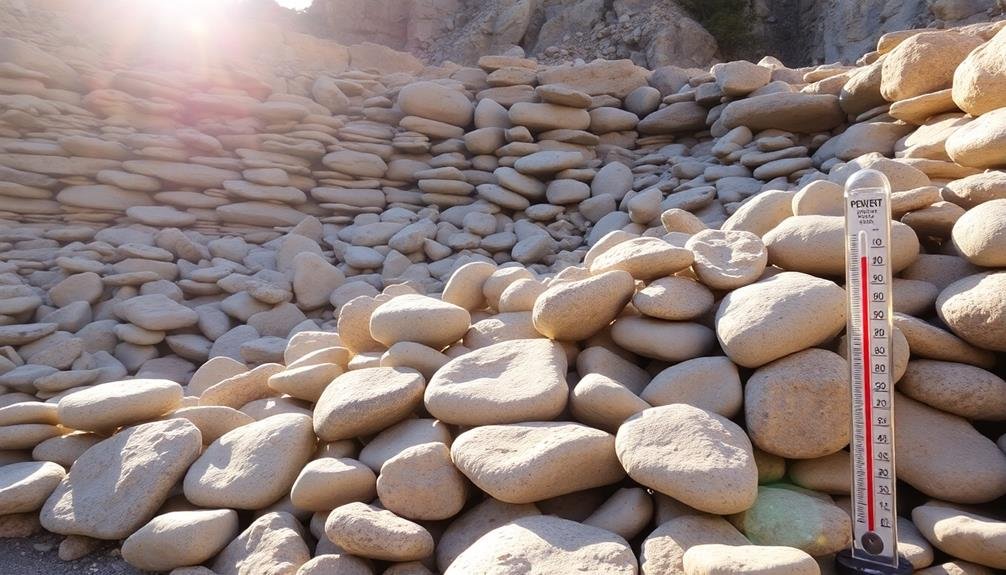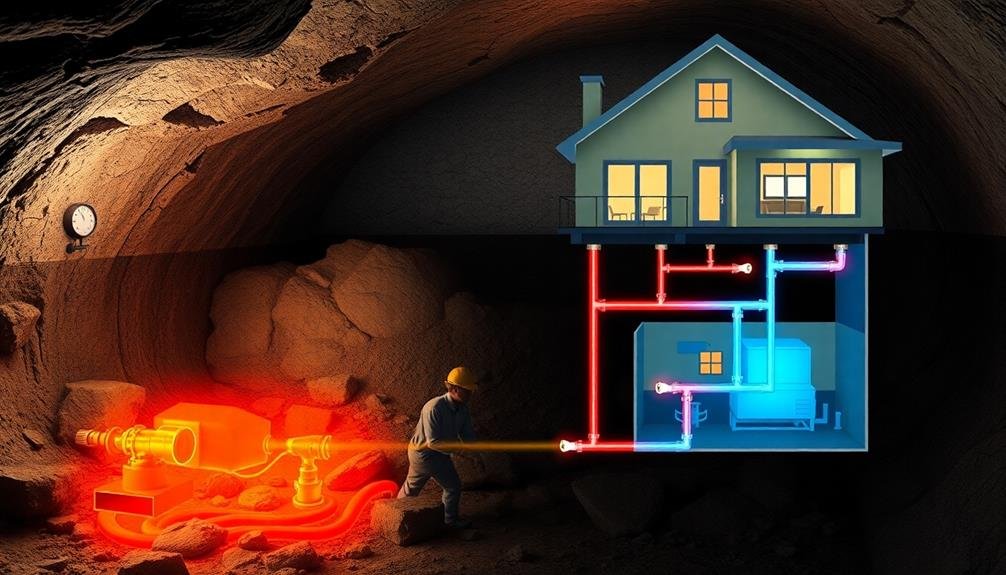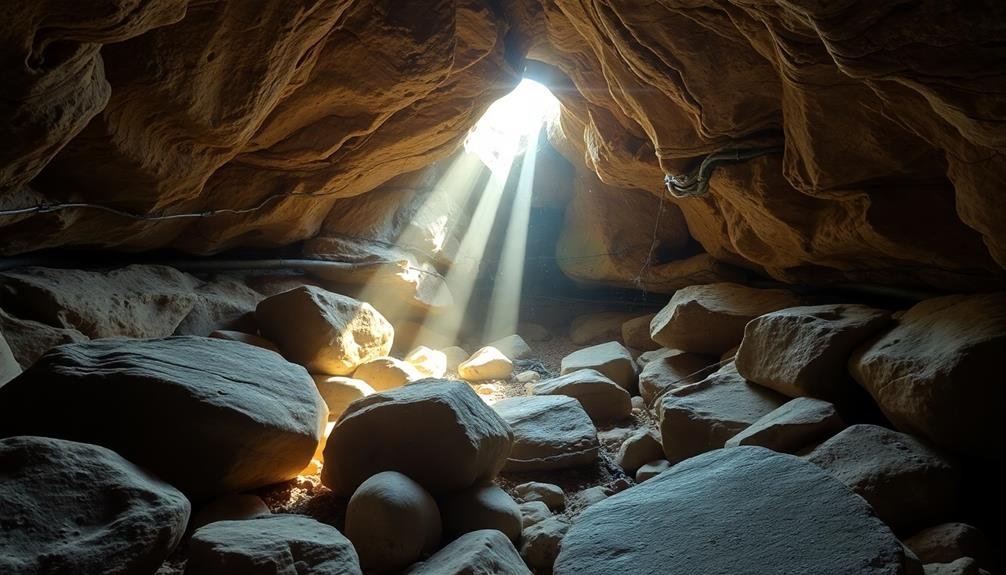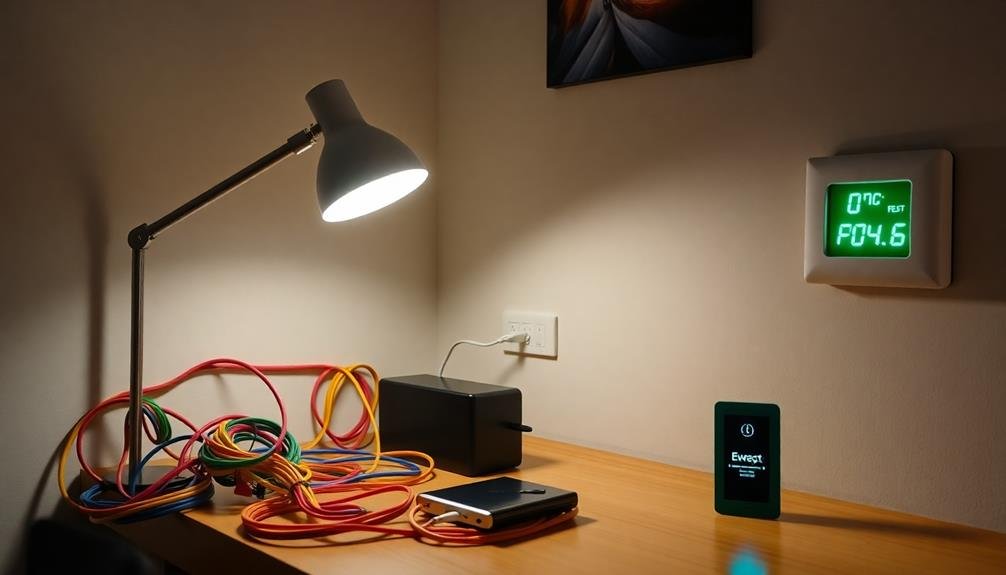Rock bed heat storage offers a natural solution for regulating your home's temperature. By circulating air through a bed of carefully selected rocks, you can store excess heat and release it when needed. This system moderates indoor temperatures year-round, reducing reliance on traditional HVAC systems and lowering energy costs. You'll enjoy improved air quality and a smaller carbon footprint. To implement this eco-friendly solution, you'll need to evaluate factors like rock type, system size, and proper insulation. With regular maintenance, your rock bed heat storage system can provide efficient temperature regulation for years to come. Discover how this innovative approach can transform your home's comfort and efficiency.
Understanding Rock Bed Heat Storage

Rock bed heat storage is a simple yet effective method of thermal energy storage that uses rocks as a medium to capture and retain heat.
It's a passive system that works by circulating hot air through a bed of rocks, typically housed in an insulated container. As the air passes through, the rocks absorb and store the heat energy.
You'll find that this system is particularly useful for solar thermal applications, where excess heat during the day can be stored for use at night or during cloudy periods.
The rocks, often granite or river stones, are chosen for their high heat capacity and durability. They can withstand repeated heating and cooling cycles without degrading.
When you need to retrieve the stored heat, cool air is circulated through the rock bed. The rocks release their stored energy, warming the air, which can then be used for space heating or other applications.
The efficiency of a rock bed system depends on factors like rock size, bed depth, and airflow rate. You'll need to optimize these parameters to achieve the best performance for your specific needs.
Benefits of Natural Temperature Regulation
One of the most significant advantages of rock bed heat storage is its natural temperature regulation capability. This system harnesses the thermal mass of rocks to maintain a stable indoor environment without relying heavily on mechanical heating or cooling.
You'll find that rock bed heat storage can effectively moderate temperature fluctuations, keeping your space comfortable year-round.
The natural regulation process works by:
- Absorbing excess heat during warm periods
- Slowly releasing stored heat when temperatures drop
- Maintaining a consistent temperature range throughout the day
By utilizing this passive system, you'll reduce your dependence on energy-intensive HVAC systems. This leads to lower utility bills and a smaller carbon footprint.
Additionally, rock bed heat storage systems require minimal maintenance, making them a cost-effective long-term solution for temperature control.
You'll also appreciate the improved air quality that comes with natural temperature regulation. Unlike traditional air conditioning systems, rock bed heat storage doesn't circulate stale air or create humidity imbalances.
Instead, it works with your home's natural airflow, promoting a healthier indoor environment. This can be particularly beneficial for those with respiratory sensitivities or allergies.
Designing Your Rock Bed System

After understanding the benefits of rock bed heat storage, it's time to focus on designing your own system. Start by determining the size of your rock bed based on your heating and cooling needs. Consider factors like your home's square footage, local climate, and desired temperature range.
Choose the right type of rocks for your bed. Opt for dense, round stones between 1-3 inches in diameter. River rocks or smooth granite pebbles work well, as they maximize heat transfer and airflow. Avoid using limestone or other soft rocks that may break down over time.
Plan your air circulation system carefully. You'll need ducts to move air through the rock bed, along with fans to control airflow. Confirm proper insulation around the bed to minimize heat loss.
Design the inlet and outlet vents strategically to optimize heat distribution throughout your space. Don't forget to incorporate a moisture barrier beneath the rock bed to prevent ground moisture from affecting the system's efficiency.
Materials and Construction Process
Once you've finalized your rock bed design, it's time to gather materials and start construction. You'll need a containment structure, typically made of concrete or insulated wood, to house your rock bed. Choose rocks that are 1-3 inches in diameter, preferably smooth and round for ideal air flow. Avoid limestone, as it can break down over time.
For the construction process, start by preparing the site and laying a foundation. Build your containment structure, ensuring it's well-insulated and airtight. Install a vapor barrier to prevent moisture from entering the system.
Next, create air ducts using PVC pipes or galvanized steel, positioning them strategically for even air distribution. As you fill the containment with rocks, consider these visual elements:
- Sunlight glinting off smooth, river-worn stones
- A cascade of rocks tumbling into place
- Neat rows of perforated pipes emerging from the rocky bed
Once filled, seal the top of the containment and connect your rock bed to your home's HVAC system. Install fans or blowers to circulate air through the bed, and add temperature sensors to monitor and control the system's performance.
With careful construction, your rock bed heat storage system will provide efficient, natural temperature regulation for years to come.
Maintenance and Performance Optimization

How can you assure your rock bed heat storage system operates at peak efficiency? Regular maintenance and performance optimization are vital.
Start by inspecting your system annually for signs of wear, moisture buildup, or structural damage. Clean or replace air filters to guarantee proper airflow and prevent dust accumulation in the rock bed.
Monitor the system's temperature differential between inlet and outlet. If it's decreasing over time, your rock bed may be losing efficiency. Consider adding insulation or replacing some of the rocks to improve heat retention.
You'll also want to check for air leaks in the ducting system, as these can greatly reduce performance.
To optimize performance, adjust the airflow rate through the rock bed. Higher flow rates increase heat transfer but may reduce overall system efficiency. Find the sweet spot for your specific setup.
Additionally, consider implementing a smart control system that adjusts airflow based on temperature differences and energy demand.
Don't forget to periodically test the rocks for degradation. If they're crumbling or showing signs of wear, it's time to replace them.
Frequently Asked Questions
Can Rock Bed Heat Storage Be Used in High-Humidity Environments?
You can use rock bed heat storage in high-humidity environments, but you'll need to take into account moisture control. Proper ventilation and waterproofing are essential. You might also want to choose moisture-resistant rocks to prevent mold and degradation.
How Long Does It Take for a Rock Bed System to Reach Optimal Efficiency?
You'll find that a rock bed system typically takes 2-4 weeks to reach peak efficiency. It depends on factors like bed size, rock type, and airflow. You'll notice gradual improvements in performance during this period.
Are There Any Safety Concerns Associated With Rock Bed Heat Storage Systems?
You should be aware of potential safety concerns with rock bed heat storage systems. They include overheating, fire risks, and air quality issues. Guarantee proper installation, regular maintenance, and adequate ventilation to minimize these risks in your system.
Can Rock Bed Heat Storage Be Integrated With Existing HVAC Systems?
Yes, you can integrate rock bed heat storage with your existing HVAC system. It'll work alongside your current setup, enhancing energy efficiency. You'll need professional help to properly connect and optimize the systems for best performance.
What's the Average Lifespan of a Rock Bed Heat Storage System?
You'll find that a well-maintained rock bed heat storage system can last 20-30 years on average. It's durable, but you'll need to check for moisture issues and rock degradation periodically. Regular inspections will help maximize its lifespan.
In Summary
You've now explored the potential of rock bed heat storage as a natural temperature regulation solution. By implementing this system, you'll harness thermal mass to maintain comfort in your space year-round. Remember to carefully design your rock bed, choose appropriate materials, and follow proper construction techniques. With regular maintenance and optimization, you'll enjoy efficient, sustainable temperature control. Embrace this eco-friendly approach to heating and cooling, and you'll reduce energy costs while minimizing your environmental impact.





Leave a Reply